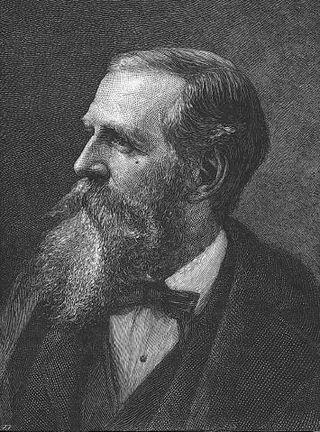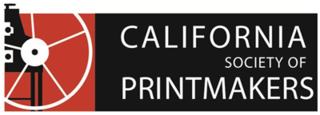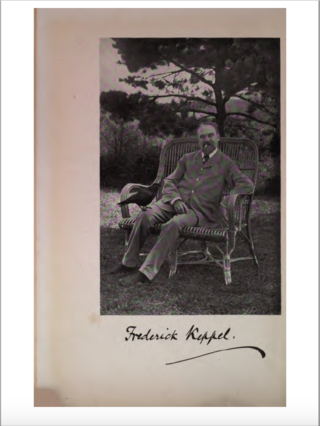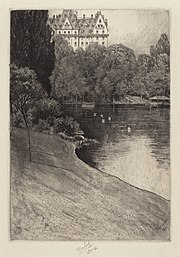
Etching is traditionally the process of using strong acid or mordant to cut into the unprotected parts of a metal surface to create a design in intaglio (incised) in the metal. In modern manufacturing, other chemicals may be used on other types of material. As a method of printmaking, it is, along with engraving, the most important technique for old master prints, and remains in wide use today. In a number of modern variants such as microfabrication etching and photochemical milling, it is a crucial technique in modern technology, including circuit boards.

Robert Swain Gifford was an American landscape painter. He was influenced by the Barbizon school and became a member of the Society of American Artists.

The etching revival was the re-emergence and invigoration of etching as an original form of printmaking during the period approximately from 1850 to 1930. The main centres were France, Britain and the United States, but other countries, such as the Netherlands, also participated. A strong collector's market developed, with the most sought-after artists achieving very high prices. This came to an abrupt end after the 1929 Wall Street crash wrecked what had become a very strong market among collectors, at a time when the typical style of the movement, still based on 19th-century developments, was becoming outdated.

The Royal Society of Painter-Printmakers (RE), known until 1991 as the Royal Society of Painter-Etchers and Engravers, is a leading art institution based in London, England. The Royal Society of Painter-Etchers, as it was originally styled, was a society of etchers established in London in 1880 and given a Royal Charter in 1888. Engraving was included within the scope of the Society from 1897, wood-engraving from 1920, coloured original prints from 1957, lithography from 1987 and all forms of creative forward-thinking original printmaking from 1990.

The California Society of Printmakers (CSP) is the oldest continuously operating association of printmakers and friends of printmakers in the United States. CSP is a 501(c)(3) non-profit arts organization with an international membership of print artists and supporters of the art of fine printmaking. CSP promotes professional development and opportunity for printmakers, and educates artists and the public about printmaking. New members are admitted by portfolio review. Friends, Institutional and Business members are admitted by fee. CSP is based in the San Francisco Bay Area, California.

Mary Nimmo Moran was an American 19th-century landscape printmaker, specializing in etchings. The first woman to prove "marriage and family were not insurmountable to success." She was the first of many landscape artists and in 1880 she was known as a landscape etcher. She completed roughly 70 landscape etchings, which included scenes of England and Scotland, as well as Long Island, New York; New Jersey, Florida, and Pennsylvania. In 1881, she was one of eight Americans and the first female elected as a fellow to London's Royal Society of Painter-Etchers. Mary Nimmo Moran's landscape View of Newark from the Meadows is in the collection of The Newark Museum of Art. She was among the earliest American Artists to explore the medium of etching.

Stephen Parrish was an American painter and etcher who became one of the 19th century's most celebrated printmakers during the "American Etching Revival." Privately trained by painter and animal etcher Peter Moran, Parrish was best known for his landscape etching of "Eastern North America, particularly the harbors and villages of New England and Canada," and as the father of painter and illustrator Maxfield Parrish.

Chicago Society of Etchers was founded in January 1910, the first organization of etchers in the country. There were 20 members to start and by 1930 there were 150 members. Membership extended outside of the United States, including artists from England, France, Italy, Germany, Sweden, India, China and Japan.

Herman Armour Webster was an American artist.

Gabrielle de Veaux Clements was an American painter, print maker, and muralist. She studied art at the Philadelphia School of Design for Women, Pennsylvania Academy of the Fine Arts, and in Paris at Académie Julian. Clements also studied science at Cornell University and graduated with a Bachelor of Science degree. She created murals, painted portraits, and made etchings. Clements taught in Philadelphia and in Baltimore at Bryn Mawr School. Her works have been exhibited in the United States and at the Paris Salon. Clements works are in several public collections. Her life companion was fellow artist Ellen Day Hale.

Agnes Dean Abbatt of New York was a painter of floral still lifes, landscapes, and coastal scenes. She was the second woman elected to the American Watercolor Society.

Frederick Keppel (1845–1912) was an American art dealer, scholar, writer, owner and founder of Frederick Keppel & Company. Keppel came to America in 1864 and became a print dealer in 1868. He was a patron and promoter of the Etching Revival and etchers including Whistler, Zorn, Buhot and Pennell. He gave Félix-Hilaire Buhot his first one-man show in 1888, and about the same time started to buy and sell a large number of Whistler's prints.
Frances Julia Farrand Dodge was an American artist and teacher.

Edith Loring Getchell was an American landscape painter and etcher, highly regarded for the "exquisite" tonalism of her etchings, drypoints and watercolors." Working during the "American Etching Revival," a period that lent legitimacy to an art form that had once been scorned as commercial, Getchell made use of the opportunities the vogue for etching gave her, despite a crowded field and the gender discrimination of her era. Considered one of America's leading etchers in her lifetime, Getchell's work is notable for its skill, its aesthetic values and its approach to depicting American landscape.
Irene Weir, was an American artist and art educator.
Sir Francis George Newbolt KC FCS was a British barrister, judge, etcher and writer. He was the Recorder of Doncaster between 1916 and 1920, and the Official Referee for the Supreme Court between 1920 and 1936, as well as being Chancellor of the Diocese of Exeter and Bradford and Chairman of the Devon Quarter Session. He was the first honorary Professor of Law at the Royal Academy of Arts.
Hermann Traugott Louis Fuechsel, also known as Füchsel or Fuchsel, was a German-American landscape painter, and member of the Düsseldorf school and Hudson River School.
Susan Fletcher Crawford ARE was a Scottish artist and printmaker, best known for her topographical etchings of Glasgow, the Scottish Highlands and other Scottish cities. Crawford was Teacher of Etching at the Glasgow School of Art between 1894 and 1917 and taught a number of artists who would become associated with the Etching Revival.

Leroy Milton Yale Jr. was a medical doctor and surgeon from New York, cofounder and first president of the New York Etching Club. He was a member of the Social Register and wrote several of books and articles on medicine and etching. He also joined the Century Association as an artist, introducing various members to the club, and actively promoted the print department of the New York Public Library.
Peter Moran, a Philadelphia-based painter and etcher, was the youngest of the artistic Moran brothers. His siblings Thomas and Edward were also painters and his brother John was an important Philadelphia photographer. Peter Moran is best known as a printmaker during the etching revival of the 1880s.














